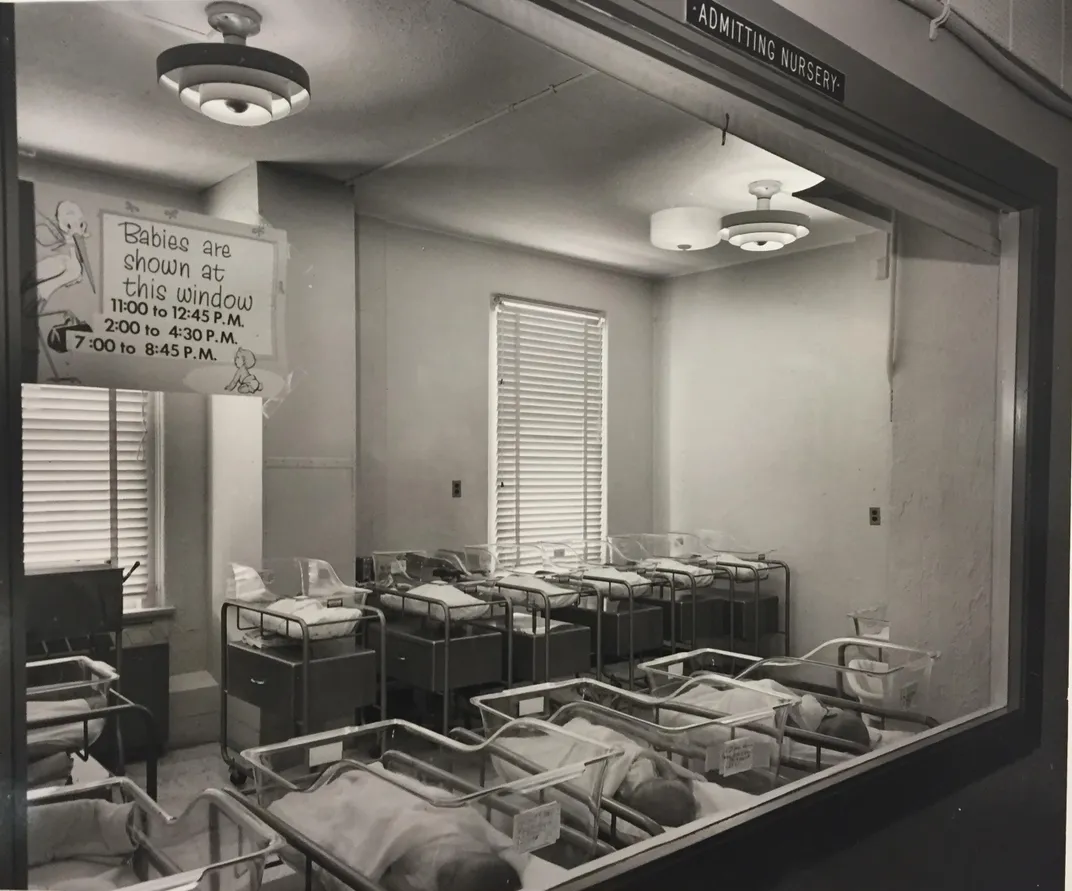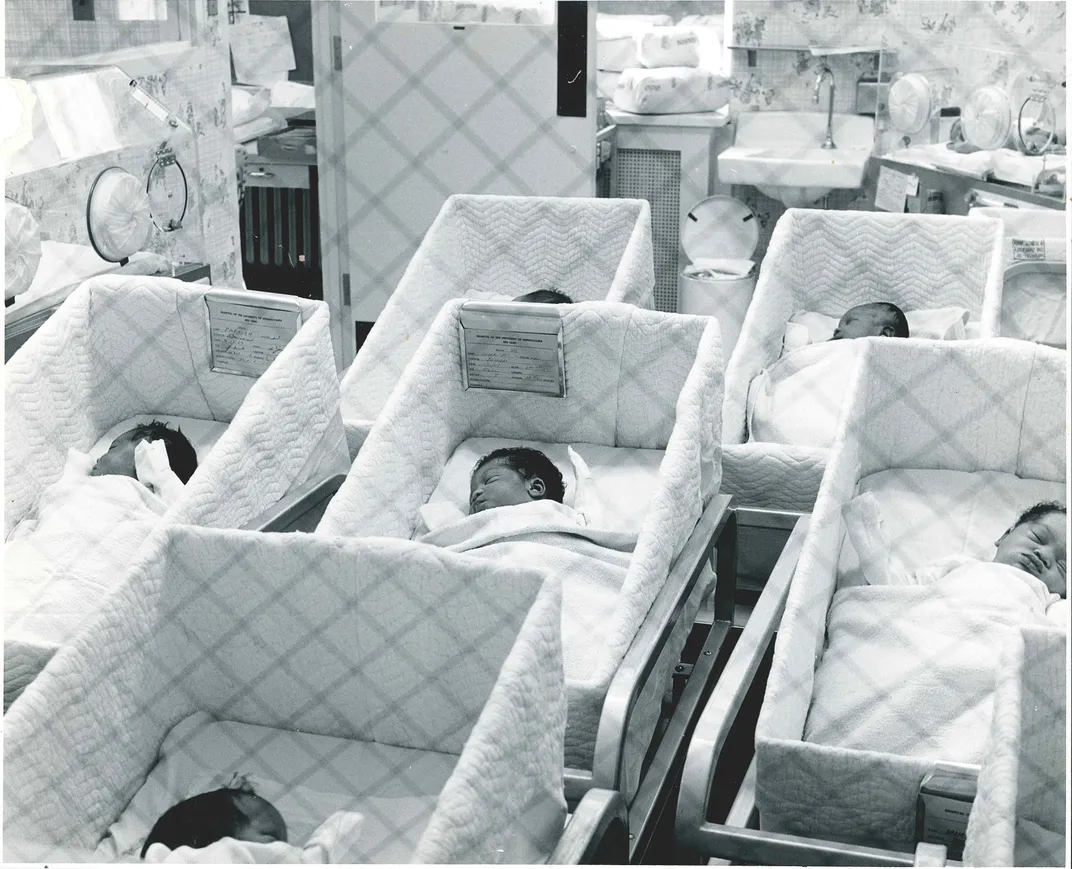What Do They Call the Room Where All New Born Babies Are Held
/https://tf-cmsv2-smithsonianmag-media.s3.amazonaws.com/filer/bd/74/bd747f5d-7ff9-4a8b-b35a-3185fe7b4d03/man-at-viewing-window-pointing-to-baby.jpeg)
Sixteen minutes into the second episode of Hulu's newHandmaid's Tale, Offred (Elizabeth Moss), having recently given birth to her first child, follows a nurse to the hospital's newborn nursery, where her infant volition take her first bathroom. Arriving at the nursery, Offred is taken aback by an unusual sight.
"Where are the babies?" she asks.
"Oh, nosotros had a difficult night. Two went to the intensive intendance unit, and the others all take died."
The camera zooms in on Offred equally she looks in through a massive window into a newborn nursery with three rows of empty bassinets. Ominous music plays in the background. The scene serves as a bad omen of things to come up for a customs grappling with widespread infertility. Every bitHandmaid'southward' creative squad understands, an empty plant nursery is jarring. That viewers of all ages and life experience tin easily recognize the gravity of a nursery devoid of babies speaks to the peculiar and item role that nursery windows have played in mod American hospitals.
Newborn nurseries became fixtures of American hospitals in the early twentieth century, during the transition from habitation to infirmary as the preferred and default place to give nativity. When hospitals built new maternity units to house women during labor, commitment, and recovery, they as well built split nurseries where newborns were cared for, en masse, autonomously from their mothers.
These nurseries all shared a striking similarity: they prominently featured large windows facing out to hospital corridors. These windows placed the hospitals' youngest patients on display for family unit, friends, hospital staff, and members of the general community. The 1943 edition ofStandards and Recommendations for Hospital Care of Newborn Infants, first published every bit a collaboration between the American University of Pediatrics and The Children'south Agency, prescribed that "A viewing window should be provided betwixt each nursery and the nurses' station, and ane between each nursery and the corridor so that relatives may see the infants without coming in contact with them."

The stated purpose for the viewing window was twofold: commencement, the window allows relatives to "meet the infants," and second, the window serves as a barrier to prevent contact between relatives and the newborns they have come to see. But while hospitals justified the construction of these windows as germ-free barriers between newborns and the general hospital community, it's unlikely that infection prevention was a main motivator. If windows served mainly every bit antibacterial barriers, the hospitals would have had no reason to install them in the first identify; standard windowless walls surrounding nurseries would have been less trouble to build, and would have eliminated the potential for compromising the barrier between the nursery and the corridor via cracks between the window and the wall. Thus, the ubiquitous plant nursery window served a primarily social office.
Roots for the practice of clinical babe viewing may lie in the late-nineteenth- and early-twentieth-century European and American tradition of incubator shows, which placed premature and otherwise weak infants on display in both permanent and traveling exhibitions. In the United States, incubator shows charged admission and displayed sick infants among "ethnic villages and freak shows," virtually famously on New York's Coney Isle.
Of course, dissimilar incubator shows, newborn nurseries were spaces for the provision of clinical care—non for entertainment—and were widely accepted and endorsed by mainstream medical organizations. Nearly importantly, the babies displayed in the windows of newborn nurseries were almost always healthy. These windows were, at their core, displays of happy, healthy, and hopeful normalcy.
While big picture windows frequently displayed the swaddled newborns to all who passed through hospitals' corridors, some nurseries had specific times in the twenty-four hours reserved for family unit members and friends to get a closer wait at a detail babe. During these more intimate viewings, a nurse would often hold a newborn up to the window and so that the eager observer could go a closer look. Admirers in this scenario could be mothers, grandparents, members of the extended family, or adoptive parents, but appear to have nigh frequently been fathers. For most of the twentieth century, fathers did not run into their babies in person until they took them dwelling, and hospitals seem to have had fathers' desires in mind when designing nursery windows. A 1950 article inThe American Journal of Nursing reported on an innovative recessed nursery window installed in a hospital in California, which they called a "Infant Showcase." This window, they wrote, "is paying dividends in public relations value and making new fathers very much happier…"
The image of a father coming together his newborn through a pane of drinking glass also appears in countless family unit photographs from the mid-twentieth century, and was immortalized in all forms, from art to advert. A total-folio ad for The Prudential Insurance Company of America in a 1943 effect ofLIFE magazine uses the archetype nursery window interaction between male parent, nurse, and baby to convince new fathers to buy life insurance. The page features a large photo of a handsome immature human being, dressed in a suit and necktie, grin into the eyes of his newborn kid through a glass window. The baby is in the arms of a nurse, who cradles the baby, tilting the child towards its father. The photograph's explanation reads, "PICTURE OF A MAN LOOKING INTO THE Time to come," and beneath the tagline: "Row upon row of tiny bassinets – and a nurse property upwardly a new baby.The baby! Only Dad sees much more than than a newborn son. He sees a long future stretching alee…"

Today, newborn nurseries are no longer considered best practice in American hospitals, and their employ is disappearing thanks in role to the widespread adoption of the WHO's 1991 Baby-Friendly Hospital Initiative (BFHI). The BFHI, a global program to promote infirmary practices that encourage breastfeeding, includes keeping salubrious mother-baby pairs together. As nurseries have begun closing, popular press coverage and professional discussions have reinforced the idea of the plant nursery window as a positive infinite in hospitals, both for babies' families and unrelated members of the community.
In 2002,The American Journal of Maternal and Child Nursing printed a argue on the topic of closing the nursery windows. Dotti James, PhD, RN, argued for keeping the windows open, in role considering for "family members, friends, and others… Seeing ane of these little miracles engenders smiles and becomes a bright spot in the day." James also noted that, "in some hospitals the nursery window has go a destination for patients and families from other parts of the hospital experiencing a health crisis," and that "Standing outside the nursery, seeing the babies who have their lives earlier them tin give promise to families trying to cope."
Also in 2002, aLos Angeles Times article echoed James' arguments, lamenting the closure of "the popular viewing areas, where infirmary visitors encumbered past some of life's darkest moments could brighten their twenty-four hours a little simply by peering through the nursery window." In the same slice, Michael Baskt, executive director of Community Memorial Hospital in Los Angeles, shared, "… For people where things are not going well, we recognize they would be attracted by the beauty of birth.Sometimes people need to get from the distressing, depressing side of the hospital to the happy side. Babies put things in perspective."
As influential thinkers and organizations go along to reimagine the postpartum period every bit a time for breastfeeding, clinically-managed bonding, and a jump start on developing the "right" mothering habits, the iconic display of newborns continues. For amend or for worse, whether in hospital-published "online nurseries," or every bit the backdrop for emotional scenes in television and movies, the tradition of the nursery window seems to be here to stay.
This story was originally published on NursingClio , a collaborative blog projection that ties historical scholarship to present-day issues related to gender and medicine.
What Do They Call the Room Where All New Born Babies Are Held
Source: https://www.smithsonianmag.com/history/why-hospitals-started-displaying-newborn-babies-through-windows-180964186/
0 Response to "What Do They Call the Room Where All New Born Babies Are Held"
Post a Comment